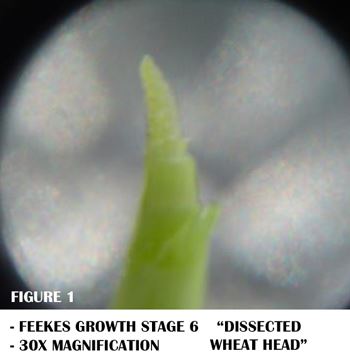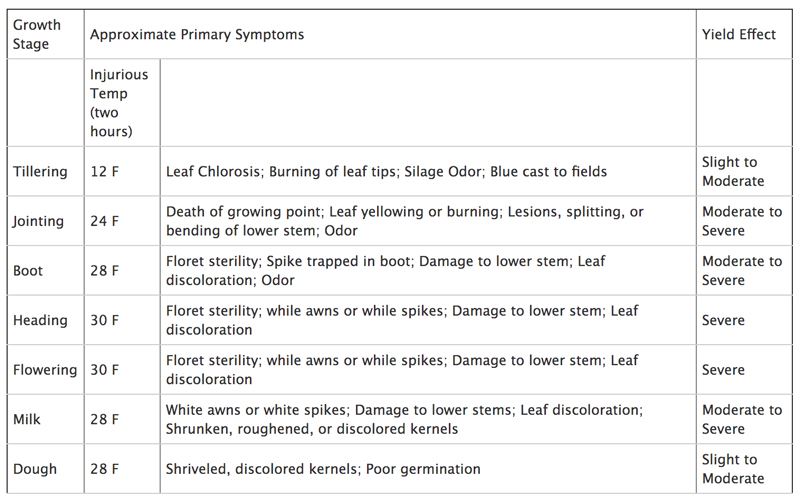Brought to you by: Jonah T. Johnson, MS, CPAg, CCA - Sales Agronomist, PCT | Sunrise
April 14, 2020: More cold temperatures are coming our way! Are your wheat and newly emerging soybean seedlings susceptible?
As I quoted in my last report, “April Showers Bring May Flowers…” as well as erratic temperature swings with the rain. This week’s forecast predicts more rainfall and much colder temperatures than last week. Some areas of Ohio are calling for nightly temperatures in the lower to upper 20’s. This is the exact reason we cautioned growers last week to be cognizant with current conditions to ensure we provide the initial 2020 crop the best chance for success.
Forecast in hand, we have two crops of concern. Ohio’s soft red winter wheat crop and newly emerging soybeans (for the handful of growers that were able to plant soybeans in late March). Both these crops have potential to be subject to cold temperature injury.
Winter wheat
Jointed wheat, or the Feekes growth stage 6 (F6 GS), signifies when the wheat plant’s growing point (aka wheat head) is now above the soil line, making this plant vulnerable to environmental impacts (such as late season frost, hail ect). This also is when protein consumption (Nitrogen uptake) begins to accelerate as stem elongation occurs and moves through vegetative growth. If “top-dress” has not occurred on your wheat yet, you still can make an “emergency” N application up to F9, prior to flag leaf emergence, with little or no yield penalty. But try not to make this a habit. Figure 1 shows a wheat head that I dissected from a “jointed” wheat plant, using a 30x hand lens in front of my iPhone camera. This confirms the F6 growth stage.
Wheat growth stage varies across the state currently, so knowing the correct stage is important in diagnosing issues. When wheat is in the “tillering” stage (wheat is still relatively short and has prostrate growth) that crop can withstand temperatures down to ~12 °F (see table below). If wheat is standing upright and just prior to joint (no detectable node) than the temperature that injury occurs is ~20°F.
If you can detect a node (jointed, growing point above the soil surface) than the temperature where injury occurs is 24°F. Cold injury at jointing can cause moderate to significant yield deficits.
The true extent of injury will not be fully evident until temperature warm up and growth resumes. But keep in mind that wheat is resilient crop, and soils buffer temperatures slower than the air, so chances are in favor that our wheat should be fine.
Forecast in hand, we have two crops of concern. Ohio’s soft red winter wheat crop and newly emerging soybeans (for the handful of growers that were able to plant soybeans in late March). Both these crops have potential to be subject to cold temperature injury.
Winter wheat

Jointed wheat, or the Feekes growth stage 6 (F6 GS), signifies when the wheat plant’s growing point (aka wheat head) is now above the soil line, making this plant vulnerable to environmental impacts (such as late season frost, hail ect). This also is when protein consumption (Nitrogen uptake) begins to accelerate as stem elongation occurs and moves through vegetative growth. If “top-dress” has not occurred on your wheat yet, you still can make an “emergency” N application up to F9, prior to flag leaf emergence, with little or no yield penalty. But try not to make this a habit. Figure 1 shows a wheat head that I dissected from a “jointed” wheat plant, using a 30x hand lens in front of my iPhone camera. This confirms the F6 growth stage.
Wheat growth stage varies across the state currently, so knowing the correct stage is important in diagnosing issues. When wheat is in the “tillering” stage (wheat is still relatively short and has prostrate growth) that crop can withstand temperatures down to ~12 °F (see table below). If wheat is standing upright and just prior to joint (no detectable node) than the temperature that injury occurs is ~20°F.
If you can detect a node (jointed, growing point above the soil surface) than the temperature where injury occurs is 24°F. Cold injury at jointing can cause moderate to significant yield deficits.
The true extent of injury will not be fully evident until temperature warm up and growth resumes. But keep in mind that wheat is resilient crop, and soils buffer temperatures slower than the air, so chances are in favor that our wheat should be fine.


Remember, when looking at fields, potential damage will show first in areas where the cold air settled: along tree lines, in low lying areas like bottoms and valleys. Other areas where damage is more likely are sandier soils which held less heat and wheat in 15” rows.
If main stems show damage, keep in mind that secondary and tertiary tillers that were not as far along in development can still contribute to yield.

Soybean Seedlings
Cold air temperatures can affect soybeans more than an emerged corn crop due to differences in the growing point phenology of a dicot (soybean) vs. monocot (corn). A corn plant’s growing point (intercalary meristem), like wheat, is below ground until the V6 growth stage. A soybean’s growing point (a.k.a. apical meristem), on the other hand, is above ground from emergence. So not only can cold water imbibition affect the initial germination, but cold air can harm tender emerged tissue as well.
Dr. Bob Nielsen at Purdue says “the severity of damage reflects the different effects of frost alone versus true lethal low temperatures, especially for corn. Corn can often survive a 'simple' frost event, wherein the exposed leaf tissue is damaged by the frost, but the growing point is not exposed to truly lethal temperatures. Lethal cold temperatures (28F or less), on the other hand, can kill the growing point even if the growing point is still below ground.”
Temperatures are usually measured several feet above the ground, thus temperatures at the soil surface can be even colder. A temperature of 28 degrees Fahrenheit for two hours is defined as a “killing” frost.
We typically recommend waiting a week to 10 days to check for “survivability” of the injured crop.
The following pictures illustrates soybean plants that experinced cold temperature damamge and those that showed signs of new growth, indicating “survivalability” of the seedling.
If you have questions regarding scouting for potential cold injury interactions, please let us know!





